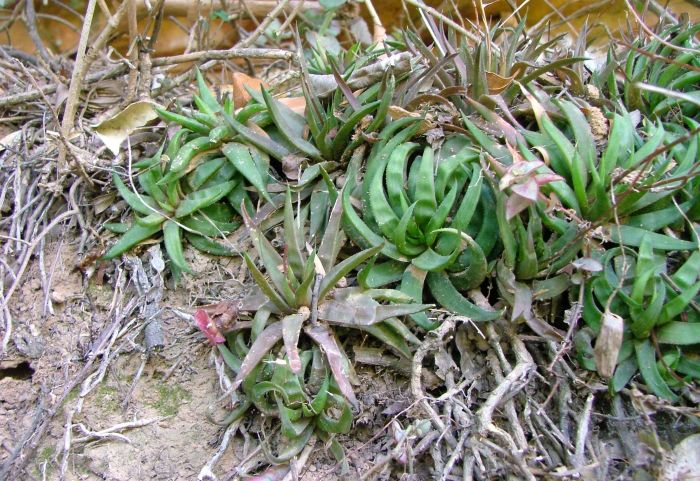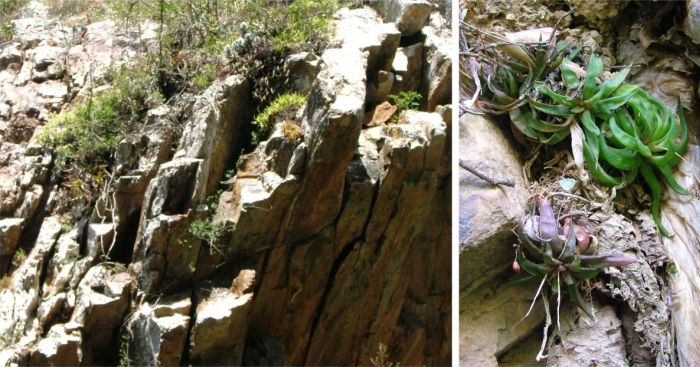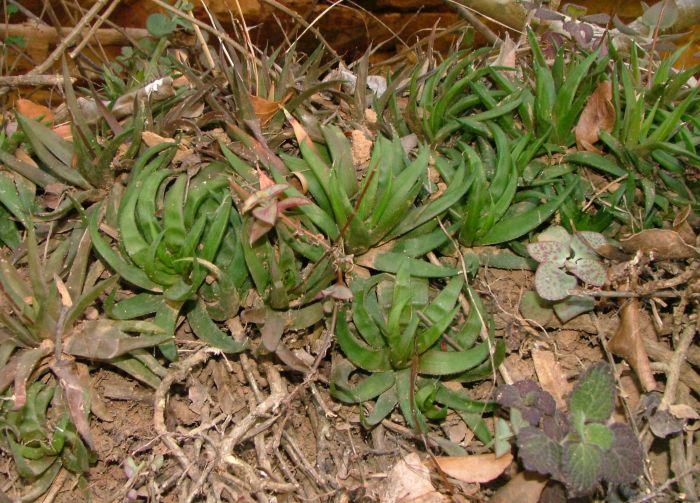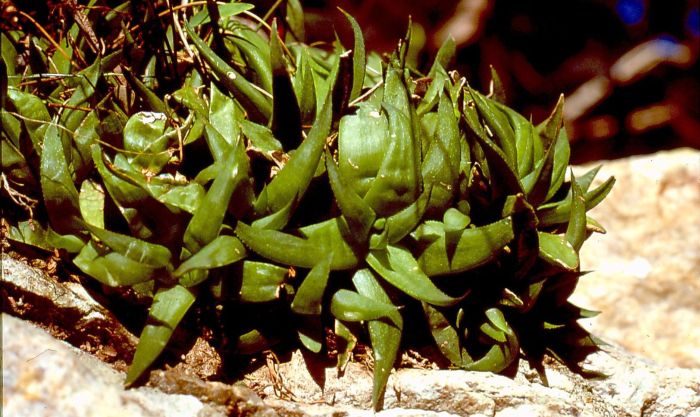Haworthia angustifolia var. baylissii
Haworthia angustifolia Haw. var. baylissii (C.L.Scott) M.B.Bayer
Family: Asphodelaceae
Common names: Witrivier Gorge haworthia (Eng.); Witrivier-dwergaalwyntjie (Afr.)
Introduction
Haworthia angustifolia var. baylissii is a dwarf cliff-hugger, with numerous small rosettes of dull green, triangular-lanceolate, succulent leaves and solitary inflorescences of white flowers in midsummer. It grows on cliffs in the Witrivier Gorge of the Suurberg in the Eastern Cape. Best grown in containers.

Fig. 1. Haworthia angustifolia var. baylissii sharing its cliff habitat with Adromischus sphenophyllus in the Witrivier Gorge, on the farm Oudekraal, Addo Elephant National Park.
Description
Description
The plants consist of dwarf-sized, rosettes in dense, small, clusters, sometimes forming mats. The plants are prolific from the base, forming roundish clusters up to 60 mm high and 120 mm in diameter and consisting of up to 12 heads. The rosettes are about 55 mm in diameter. The roots are greyish and rounded (terete). The leaves are triangular-lanceolate, up to 20, in a rosette, ascending at first and becoming spreading and recurved. The upper surface is flat to slightly channelled, boat-shaped (cymbiform) below with a smooth surface, becoming purplish during dry periods. The margin is ciliate with an acute or pointed tip (apex) ending with a hair-like projection (aristate). The inflorescence consists of a simple raceme, 130–250 mm long bearing 8–15-flowers in the upper half, the bracts white and clasping, up to 3 mm long, ovate-acuminate. The flower stalk (pedicel) is about 1.5 mm long. The flowers (perianth) are tubular, 2-lipped, curved, ascending-spreading, 15–18 mm long, white with a green midstripe. The ovary is tubular, 2 × 1.5 mm, green; the stigma 1 mm long, widening and truncate at the apex.
Flowering is usually in midsummer (January to February in the southern hemisphere). Seeds are dispersed by wind, in late summer and early autumn.

Fig. 2. A cluster of Haworthia angustifolia var. baylissii growing on a ledge on a sheer cliff at the Witrivier Gorge (Farm Oudekraal, Addo Elephant National Park).
Conservation Status
Status
Haworthia angustifolia is assessed as range restricted but relatively common and not threatened, and has been classified as Least Concern (LC) by the Red List of South African plants. The subspecific taxa have not yet been evaluated. Haworthia angustifolia var. baylissii is confined to the Witrivier Gorge (Suurberg) in the Addo Elephant National Park (Eastern Cape) and is well protected by its difficult to reach, sheer cliff-face habitat that falls within a greater conservation region. Consequently it can be regarded as not threatened.
Distribution and habitat
Distribution description
Haworthia angustifolia var. baylissii is only known from the farm Oudekraal, in a long, narrow gorge on the Witrivier through the Suurberg of the Eastern Cape.
Plants grows on sheer, shady cliffs (all aspects), at an altitude 400–500 m. The plants are firmly rooted in crevices, their size often depending on the growing space allowed by the crevice. The temperature can be high on some days, up to 35–40°C. Winters are cooler but frost is absent. Rainfall can occur throughout the year but with a peak in spring and summer, ranging from 400–500 mm per annum (thunder showers or cyclonic winter rain).
The associated vegetation consists of Sundays Thicket of the Albany Thicket Biome (Mucina et al. 2006). Associated cliff-dwelling plants include Bulbine suurbergensis, Coleus madagascariensis, Crassula cordata, C. intermedia, C. pellucida subsp. marginalis and C. perfoliata var. minor, Haworthiopsis glauca, Lampranthus affinis, Ledebouria concolor and Ornithogalum juncifolium.
The geology consists of mineral-poor, quarzitic sandstone (light-coloured and smooth-textured), Witteberg Group, Witpoort Formation (Cape Supergroup). The cliffs have many ledges, crevices and fissures, that are ideal for establishment of plants.

Fig. 3. A young cluster of Haworthia angustifolia var. baylissii sharing its cliff habitat with Ledebouria concolor in the Witrivier Gorge, on the farm Oudekraal, Addo Elephant National Park.
Derivation of name and historical aspects
History
Haworthia angustifolia var. baylissii was named by Charles. L. Scott, in the Journal of South African Botany in 1968, as Haworthia baylissii, from plants collected by the plant explorer, Roy Bayliss (1909–1994), an enthusiastic collector of succulent plants. He also collected a small rough-leafed Gasteria in the same gorge later named G. baylissiana. Bruce Bayer, Haworthia expert from the Karoo National Botanical Garden, changed its status to a variety of H. angustifolia on grounds that the spreading to recurved, flat, triangular-lanceolate leaves are not sufficiently different to warrant its status as an independent species. Haworthia angustifolia was named by Adrian Haworth in the Philosophical Magazine in 1825.
Haworthia angustifolia var. baylissii is related to Haworthia angustifolia var. angustifolia, a chasmophyte (plant growing in crevices and fissures on rocks), occurring on exposed rocky outcrops in grassy fynbos. The latter has narrow, lanceolate, acuminate leaves that are well-camouflaged among its grassy fynbos habitat. Haworthia angustifolia var. baylissii retains its flat, triangular-lanceolate, spreading leaves in cultivation.
Haworthia is a large genus of about 45 species within the Aloe family, Asphodelaceae, as acknowledged by Mr Bruce Bayer, Haworthia specialist and former curator of the Karoo National Botanical Garden in Worcester (SANBI). It is distinct from Tulista and Haworthiopsis. It differs from these by its perianth (flower) of which the base is triangular or rounded-triangular, an upcurved style and obclavate perianth tube (upside down club-shaped).

Fig. 4. A dense, mat-forming group of Haworthia angustifolia var. baylissii sharing its cliff habitat with Crassula cordata, Crassula pellucida subsp. marginalis and Coleus madagascariensis, in the Witrivier Gorge, on the farm Oudekraal Addo Elephant National Park.
Ecology
Ecology
Haworthia angustifolia var. baylissii grows on shady cliffs and the flattened, spreading to recurved leaves are an adaptation to maximise light absorption. This is similar to other rosulate succulents, such as Aloe dabenorisana which also grows on shady cliffs. The leaves are green, becoming purplish during dry periods as the plants aestivate, blocking out excessive light and reducing photosynthesis.
Plants are long-lived, the soft leaves withering from the base, becoming turgid after rain but channelled during dry periods, an adaptation to the extreme, dry habitat.
The soft leaf texture and entire margin (occasionally ciliate) suggest a reduction in armament in response to the undisturbed cliff habitat, in contrast to the thorny plants in in the heavily grazed, surrounding thicket vegetation.
The ascending, spreading, wiry inflorescence has white, 2-lipped, tubular flowers in midsummer that attract a flying insect that pollinates them.
Seeds are small, ideal for establishment in crevices. The light, angular seeds are shaken from the capsules and dispersed by wind. The seeds ripen in late summer and autumn, coinciding with the autumn rains. Germination is within 14–21 days.
Haworthia angustifolia var. baylissii suckers freely from the base, forming dense, rounded clusters or loose mats. Continual sprouting from the base represents an efficient vegetative backup dispersal strategy for this harsh cliff-face environment. Detached clusters or heads will also root if they fall into a suitable crevice.
Uses
Use
No medicinal or cultural uses have been recorded.

Fig. 5. A close-up of a cultivated specimen of Haworthia angustifolia var. baylissii.
Growing Haworthia angustifolia var. baylissii
Grow
Haworthia angustifolia var. baylissii is easily grown from seed or division. It is best grown as a pot plant in partial shade, on a balcony or windowsill, and kept in small containers, simulating the small crevices of the cliff environment. The young plant starts solitary, soon dividing forming small, dense clusters. Outside its habitat, it is best grown under controlled conditions in a greenhouse.
The soil should be sandy, well-drained and slightly acid, as it is found in its natural habitat. They will react well to any fertiliser, but organic fertiliser is best, such as well broken-down compost. Feed plants amply throughout the year. In its habitat at the Witrivier Gorge, Suurberg in the Eastern Cape, rain can be expected any time of the year but more so from spring to autumn. It is best to water well during summer and keep dry in winter. The plant is also frost-prone and should be protected the winter.
Sow seed in spring, summer or autumn, in a sandy medium. First moisten the substrate with a fine rose. Cover the seed lightly with a thin layer of sand. Keep moist and in a shady position. Germination is usually within 3 weeks and the young seedlings are relatively fast growing. Transplant seedlings to individual containers once large enough to handle.
Divide plants at any time of the year, plant in a shallow tray, in a sandy mixture (e.g. peat, sand and polystyrene) and keep moist. Rooting is within 3 weeks, and once well rooted, transfer to individual containers. Place container in a shady position but with full light. The south side of a building is ideal.
Plants are relatively disease free, but aphids, slugs and snails can sometimes be a problem.
References
- Haworth, A.H. 1825. Decas quinta novarum plantarum succulentarum. The Philosophical Magazine 66: 279–283.
- Mucina, L. & Rutherford, M.C. (eds) 2006. The vegetation of South Africa, Lesotho and Swaziland. Strelitzia 19. South African National Biodiversity Institute, Pretoria.
- Raimondo, D. & von Staden, L. 2014. Haworthia angustifolia Haw. National Assessment: Red List of South African Plants version 2020.1. Accessed on 2021/07/09
- Scott, C.L. 1968. A new species of Haworthia. Journal of South African Botany 34: 1.
- Van Jaarsveld, E.J. & Forster, P.I. 2001. Bulbine. In U. Eggli, Sukkulenten Lexicon (Band 1). Einkeimblattrige Pflanzen (Monocotyledonen). Ulmer, Stuttgart.
Credits
Ernst van Jaarsveld
Kirstenbosch National Botanical Garden (Retired 2015)
Babylonstoren Farm
Extraordinary senior lecturer and researcher,
Department of Biodiversity and Conservation, University of the Western Cape
July 2021
Plant Attributes:
Plant Type: Succulent
SA Distribution: Eastern Cape
Soil type: Sandy
Flowering season: Late Summer
PH: Acid
Flower colour: Green, White
Aspect: Shade, Morning Sun (Semi Shade)
Gardening skill: Easy
Special Features:
Horticultural zones








Rate this article
Article well written and informative
Rate this plant
Is this an interesting plant?
Login to add your Comment
Back to topNot registered yet? Click here to register.